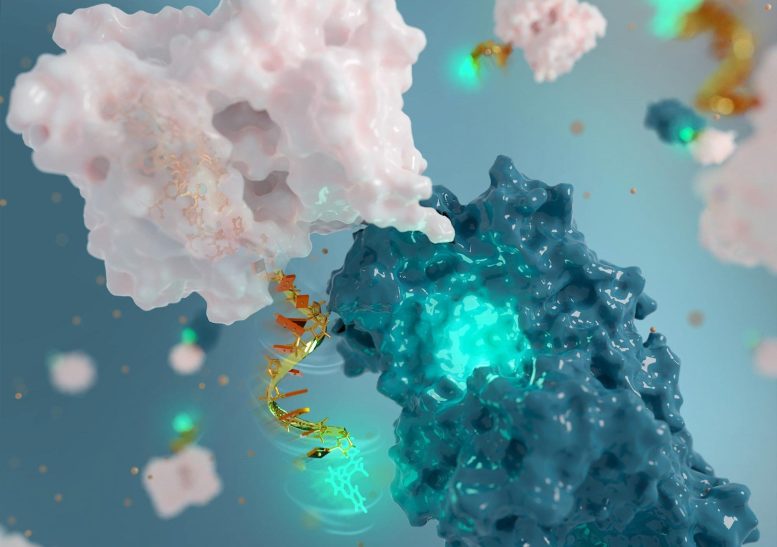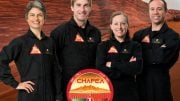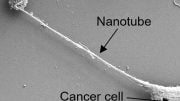
Like a two-way radio that can both receive and transmit radio waves, the fluorescent nanoantenna designed by Alexis Vallée-Bélisle and his team receives light in one color and depending on the protein movement it senses, then transmits light back in another color, which we can detect. One of the main innovations of these nanoantennas is that the receiver part of the antenna (bright green) is also employed to sense the molecular surface of the protein studied via molecular interaction. Credit: Caitlin Monney
A new nanoantenna can track protein dynamics in real-time using DNA-based technology. This innovation promises advancements in understanding diseases and developing nanotechnologies.
Researchers at Université de Montréal have created a nanoantenna to monitor the motions of proteins. Reported recently in Nature Methods, the device is a new method to monitor the structural change of proteins over time – and may go a long way to helping scientists better understand natural and human-designed nanotechnologies.
“The results are so exciting that we are currently working on setting up a start-up company to commercialize and make this nanoantenna available to most researchers and the pharmaceutical industry,” said UdeM chemistry professor Alexis Vallée-Bélisle, the study’s senior author.
Technological Inspiration From DNA
Over 40 years ago, researchers invented the first DNA synthesizer to create molecules that encode genetic information. “In recent years, chemists have realized that DNA can also be employed to build a variety of nanostructures and nanomachines”, added the researcher, who also holds the Canada Research Chair in Bioengineering and Bionanotechnology.
“Inspired by the ‘Lego-like’ properties of DNA, with building blocks that are typically 20,000 times smaller than a human hair, we have created a DNA-based fluorescent nanoantenna, that can help characterize the function of proteins,” he said
“Like a two-way radio that can both receive and transmit radio waves, the fluorescent nanoantenna receives light in one color, or wavelength, and depending on the protein movement it senses, then transmits light back in another color, which we can detect.”
Advancements in DNA-Based Nanoantennas
One of the main innovations of these nanoantennae is that the receiver part of the antenna is also employed to sense the molecular surface of the protein studied via molecular interaction.
One of the main advantages of using DNA to engineer these nanoantennas is that DNA chemistry is relatively simple and programmable,” said Scott Harroun, an UdeM doctoral student in chemistry and the study’s first author.
“The DNA-based nanoantennas can be synthesized with different lengths and flexibilities to optimize their function,” he said. “One can easily attach a fluorescent molecule to the DNA, and then attach this fluorescent nanoantenna to a biological nanomachine, such as an enzyme.
“By carefully tuning the nanoantenna design, we have created a five-nanometer-long antenna that produces a distinct signal when the protein is performing its biological function.”
Potential Applications and Future Prospects
Fluorescent nanoantennas open many exciting avenues in biochemistry and nanotechnology, the scientists believe.
“For example, we were able to detect, in real-time and for the first time, the function of the enzyme alkaline phosphatase with a variety of biological molecules and drugs,” said Harroun. “This enzyme has been implicated in many diseases, including various cancers and intestinal inflammation.
“In addition to helping us understand how natural nanomachines function or malfunction, consequently leading to disease, this new method can also help chemists identify promising new drugs as well as guide nanoengineers to develop improved nanomachines,” added Dominic Lauzon, a co-author of the study doing his PhD in chemistry at UdeM.
One main advance enabled by these nanoantennas is also their ease of use, the scientists said.
“Perhaps what we are most excited by is the realization that many labs around the world, equipped with a conventional spectrofluorometer, could readily employ these nanoantennas to study their favorite protein, such as to identify new drugs or to develop new nanotechnologies,” said Vallée-Bélisle.
Reference: “Monitoring protein conformational change using fluorescent nanoantennas” by Scott G. Harroun, Dominic Lauzon, Maximilian C. C. J. C. Ebert, Arnaud Desrosiers, Xiaomeng Wang and Alexis Vallée-Bélisle, 30 December 2021, Nature Methods.
DOI: 10.1038/s41592-021-01355-5
Funding was provided by the Natural Sciences and Engineering Research Council of Canada; the Fonds de recherche du Québec – Nature et technologies; Canada Research Chairs; the Quebec Network for Research on Protein Function, Engineering, and Applications; and Université de Montréal.









Babu G. Ranganathan*
(B.A. Bible/Biology)
HOW DOES DNA TURN A CELL INTO A SHEEP, OR A BIRD, OR A HUMAN?
When you divide a cake, the cake never gets bigger. However, when we were just a single cell and that cell kept dividing we got bigger. New material had to come from somewhere. That new material came from food.
Just as the sequence of various letters and words in human language communicate a message and direct workers to build and assemble something so, too, the sequence of various molecules in our DNA (our genes or genetic code) directed molecules (i.e. various amino acids, the building blocks of proteins) from our mother’s food, that we received in the womb, to become new cells, eventually forming all the tissues and organs of our body. Food isn’t just for energy. It’s also material used by the body to make new cells. After all, when we eat meat or vegetables we’re actually eating cells of animals and plants.
When you feed a cat your food the cat’s DNA will direct the food molecules to become the cells, tissues, and organs of a cat, but your DNA will turn the same food into human cells, tissues, and organs.
What we call “genes” are actually segments of the DNA molecule. When you understand how your DNA works, you’ll also understand how egg yolks can turn into chickens. Read my popular Internet article: HOW DID MY DNA MAKE ME? Just google the title to access the article.
This article will give you a good understanding of how DNA, as well as cloning and genetic engineering. You also learn that so-called “Junk DNA” isn’t junk at all. You will learn why it is not rational to believe that DNA code could have arisen by chance. Science points (not proves, but points) to an intelligent cause for DNA code.
What about genetic and biological similarities between species? Genetic information, like other forms of information, cannot happen by chance, so it is more logical to believe that genetic and biological similarities between all forms of life are due to a common Designer who designed similar functions for similar purposes. It doesn’t mean all forms of life are biologically related! Only genetic similarities within a natural species proves relationship because it’s only within a natural species that members can interbreed and reproduce.
Nature cannot build DNA code from scratch. It requires already existing DNA code to direct and bring about more DNA code or a genetic engineer in the laboratory using intelligent design and highly sophisticated technology to bring DNA code into existence from scratch. Furthermore, RNA/DNA and proteins are mutually dependent (one cannot come into existence without the other two) and cannot “survive” or function outside of a complete and living cell. DNA code owes its existence to the first Genetic Engineer – God!
Protein molecules require that various amino acids come together in a precise sequence, just like the letters in a sentence. If they’re not in the right sequence the protein won’t function. DNA and RNA require for various their various nucleic acids to be in the right sequence.
Furthermore, there are left-handed and right-handed amino acids and there are left-handed and right-handed nucleic acids. Protein molecules require for all their amino acids to be left-handed only and in the right sequence. DNA and RNA require for all their nucleic acids to be right-handed and in the right sequence. It would take a miracle for DNA, RNA, and proteins to arise by chance!
Mathematicians have said any event in the universe with odds of 10 to 50th power or greater is impossible! The probability of just an average size protein molecule (with its amino acids in the right sequence) arising by chance is 10 to the 65th power. Even the simplest cell is made up of many millions of various protein molecules along with and DNA/RNA..
The late great British scientist Sir Frederick Hoyle calculated that the odds of even the simplest cell coming into existence by chance is 10 to the 40,000th power! How large is this? Consider that the total number of atoms in our universe is 10 to the 82nd power.
Also, so-called “Junk DNA” isn’t junk. Although these “non-coding” segments of DNA don’t code for proteins, they have recently been found to be vital in regulating gene expression (i.e. when, where, and how genes are expressed, so they’re not “junk”). Also, there is evidence that, in certain situations, they can code for proteins through the cell’s use of a complex “read-through” mechanism.
Visit my latest Internet site: THE SCIENCE SUPPORTING CREATION (This site answers many arguments, both old and new, that have been used by evolutionists to support their theory)
Author of the popular Internet article, TRADITIONAL DOCTRINE OF HELL EVOLVED FROM GREEK ROOTS
*I have given successful lectures (with question and answer period afterwards) defending creation before evolutionist science faculty and students at various colleges and universities. I’ve been privileged to be recognized in the 24th edition of Marquis “Who’s Who in The East.”
babu the dumb bum (aka bible/biologist) is at it again, begging people to visit his dumb articles so that he can earn a few rupees. Come on people, he has to pay that diploma mill which produced his “BA in bible/biology”… roflmao.